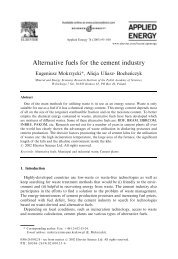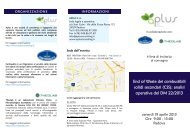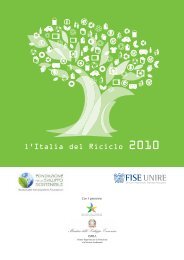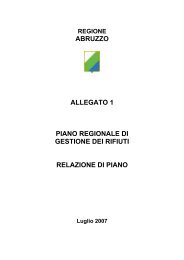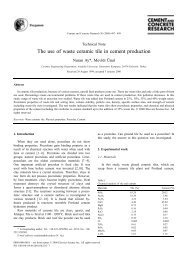GUIDELINES Disposal of Wastes in Cement Plants - BAFU
GUIDELINES Disposal of Wastes in Cement Plants - BAFU
GUIDELINES Disposal of Wastes in Cement Plants - BAFU
Create successful ePaper yourself
Turn your PDF publications into a flip-book with our unique Google optimized e-Paper software.
<strong>GUIDELINES</strong> <strong>Disposal</strong> <strong>of</strong> Waste <strong>in</strong> <strong>Cement</strong> <strong>Plants</strong> 6<br />
Table 1:<br />
Element<br />
Guidance values for pollutant content <strong>of</strong> wastes not conta<strong>in</strong>ed <strong>in</strong> the positive<br />
list.<br />
Guidance value [mg/kg dry matter]<br />
Column A for<br />
combustible wastes (left:<br />
<strong>in</strong> mg/MJ; right: <strong>in</strong><br />
mg/kg, based on a lower<br />
calorific value <strong>of</strong> 25<br />
MJ/kg)<br />
mg/MJ mg/kg (at<br />
Column B for<br />
wastes used as<br />
alternative raw<br />
materials<br />
mg/kg<br />
Column C for wastes<br />
used as constituents at<br />
the gr<strong>in</strong>d<strong>in</strong>g stage <strong>in</strong><br />
the production <strong>of</strong><br />
Portland cement<br />
mg/kg<br />
25 MJ/kg)<br />
Arsenic As 0.6 15 20 30<br />
Antimony Sb 0.2 5 5 5<br />
Barium Ba 8 200 600 1000<br />
Beryllium Be 0.2 5 3 3<br />
Lead Pb 8 200 50 75<br />
Cadmium Cd 0.08 2 0.8 1<br />
Chromium Cr 4 100 100 200<br />
Cobalt Co 0.8 20 30 100<br />
Copper Cu 4 100 100 200<br />
Nickel Ni 4 100 100 200<br />
Mercury Hg 0.02 0.5 0.5 0.5<br />
Selenium Se 0.2 5 1 5<br />
Silver Ag 0.2 5 - -<br />
Thallium Tl 0.12 3 1 2<br />
Vanadium V 4 100 200 300<br />
Z<strong>in</strong>c Zn 16 400 400 400<br />
T<strong>in</strong> Sn 0.4 10 50 30<br />
TOC, toxic<br />
organic<br />
compounds<br />
No general guidance value. Special procedure accord<strong>in</strong>g to OAPC, Appendix 2, subsection<br />
719, and the rule <strong>of</strong> m<strong>in</strong>imisation whenever substances such as PCB, diox<strong>in</strong>s or similar<br />
toxic compounds are suspected. For PCB <strong>in</strong> waste materials, the values specified <strong>in</strong> Section<br />
5.2.2 or <strong>in</strong> the positive list are applicable. For organic compounds <strong>in</strong> general, Section 4.2<br />
shall be observed.<br />
Notes to Table 1<br />
Column A applies to wastes used as fuel <strong>in</strong>troduced either <strong>in</strong> the ma<strong>in</strong> burner at the cl<strong>in</strong>ker<br />
outlet <strong>of</strong> the rotat<strong>in</strong>g kiln or the <strong>in</strong>let <strong>of</strong> the rotat<strong>in</strong>g kiln. The guidance values <strong>in</strong> column A<br />
[mg/MJ] are based on the lower calorific value <strong>of</strong> the waste. For reasons <strong>of</strong> clarity, the<br />
guidance values <strong>in</strong> [mg/kg waste] are also given, based on a lower calorific value <strong>of</strong> 25<br />
MJ/kg. The value <strong>of</strong> 25 MJ/kg corresponds to the calorific value <strong>of</strong> hard coal. If the<br />
calorific value <strong>of</strong> the waste is lower or greater than 25 MJ/kg, the permissible heavy metal<br />
content changes proportionally.<br />
Column B applies to wastes used as alternative raw materials and corrective raw<br />
materials <strong>in</strong> produc<strong>in</strong>g cl<strong>in</strong>ker. This waste substitutes part <strong>of</strong> the raw material normally<br />
used or serves to correct the raw meal composition, i.e. the calcium, iron, silicon or<br />
alum<strong>in</strong>ium content (accord<strong>in</strong>g to the remarks on page 46 <strong>of</strong> the "Thesenpapier").



